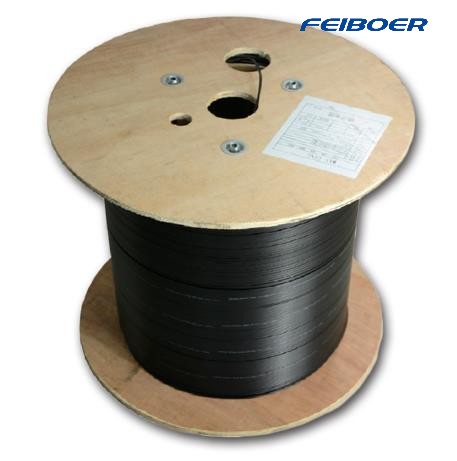FTTH (fiber to the home) networks are deployed everywhere, including indoor sections, outdoor sections, and transitions. There’re different types of fiber optic cables, and each is well designed to fulfill the cabling requirements of specific regions. As an essential part of the FTTH network, the drop cable is the media between the end-users and the feeder cable. Today we’ll discuss this special outdoor fiber optic cable in detail.
Drop cables connect the terminal of a distribution cable to a subscriber’s premises. Typically small diameter, low fiber count cables with limited unsupported span lengths, drop cables are installed aerially, underground, or buried. According to the industry standard, drop cable shall have a minimum pull strength of 1335 Newtons.

Features
Choice of fiber types
Single-mode optical fiber meting ITU T G.657A1 or ITU T G.657A2
Individually colored optical fibers (blue, orange, green, brown)
Notched 2 x 3 mm construction for easy stripping
White LSZH jacket for internal use
Black LSZH jacket for short distance external use
Compact cable construction
FRP strength member
Conforms to IEC standard
Applications
Internal FTTH applications horizontal and riser
Clipping to surfaces, including skirting boards
Short distance external use with black LSZH jacket
Types of FTTH Drop Cable
Available in many different styles, the three most used drop cables described below are divided according to the cable structure.
Flat Type Drop Cable
Short for the flat drop cable. With a flat-out looking, it usually comprises a polyethylene jacket, several fibers, and two dielectric strength members to give high crush resistance. Though drop cable often contains one or two lines, its thread counts up to 12 or more are also available.
Figure 8 Aerial Drop Cable
A self-supporting cable. The line fixed to a steel wire is designed for easy and economical aerial installation of outdoor applications. This type of drop cable is set to a steel wire. Typical fiber counts of figure 8 Drop Cable are 2 to 48, with a tensile load of 6000 Newtons.
Round Drop Cable
This variant usually contains a single bend-insensitive fiber buffered and surrounded by dielectric strength members and an outer jacket, which can provide durability and reliability in the drop segment of the network.
Drop Cable Connectivity Method: Splice or Connector?
Among all components essential to the FTTH network, the drop cable, as the final connection from the fiber optic network to customer premises, plays an important role. Therefore, broadband service must find a flexible, efficient, and cost-effective connectivity method. There’re two termination methods, i.e., using a fiber optic connector that can be easily mated and unmated by hand or using a permanent splice? The following will offer the answer and the solutions for your applications.
A fusion splice can eliminate the possibility that the termination point becomes damaged or dirty. Therefore, it has better optical performance than a fiber optic connector.
Yet it has its disadvantage.
The fusion splice lacks operational flexibility compared with the fiber optic connector. And flexibility matters. A fiber optic connector can provide an access point for networking testing, which cannot be supplied by thermal fusion.
Then how to choose between them?
Generally, the splice is recommended for drop cables in places where no future fiber rearrangement is necessary, like a greenfield or new construction application where the service provider can easily install all the drop cables. A fiber optic connector is appropriate for applications requiring flexibility, like ONTs, which have a connector interface.
03-21
202502-12
202509-12
202409-05
202408-16
202408-07
202408-06
202408-02
202407-30
202407-29
2024
